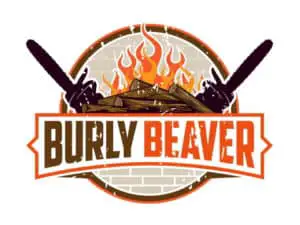Chainsaw bar oil is an extremely important part of a well-functioning chainsaw. And if you’re reading this, then you’re probably wondering: why is my chainsaw bar not getting oil?
The most common reason a chainsaw oiler stops working is that the oil hole gets clogged. To fix this, remove the chain and bar from your chainsaw and clean the oil hole and oil outlet port. If this doesn’t fix the problem, you’ll probably need to replace the oil line or pump.
Before you assume your oiler isn’t working though, I would advise you to check your oil tank and make sure it’s filled. If that’s not the problem, then go ahead and move on to the other stuff we discuss below.
What is a Chain Oiler?
Before we get into diagnosing the issue with your oiler, we first need to discuss what a chain oiler is and how it works.
A chain oiler is a pump in your chainsaw that automatically pumps oil into the bar groove which is then picked up by the chain while it’s running.
This oil lubricates your chain to decrease the friction of your chain across your bar. This keeps your saw running smoothly and efficiently.
If your chainsaw’s oiler isn’t working, it could cause your chainsaw to smoke which is a telltale sign that something isn’t working right.
To lubricate your bar and chain, the oiler uses (you guessed it) bar and chain oil. This oil is filled in its own tank, usually towards the front of your saw.
Important distinction: bar and chain oil is not the same as the engine oil that is mixed in with chainsaw fuel.
Make sure you don’t confuse your bar and chain oil with engine oil, this could spell disaster for your saw.
Now that we’ve covered what an oiler is and why it’s important, let’s get into figuring out why it’s not working.
Why is My Chainsaw Oiler Not Working? And How to Fix It.
There are a few different reasons your oiler might not be working, and the first thing you should check is if the oil tank is empty. I know it seems like common sense, but I’m here to give you answers, even if they may seem obvious.
If your saw has oil in it but it’s not getting to your chain, then your oiler is either clogged or you have a faulty oil line or pump.
Let’s test out each of these potential solutions step-by-step.
Oil Tank Empty
First off, let’s get the easiest thing out of the way first: refilling your oil tank.
Your oil tank will be located towards the front of your saw and is usually indicated by a little chain oil symbol. In the picture below, you can clearly see the black cap with the oil droplet symbol above it. That’s the bar oil tank.

Keep in mind, not all brands are the same, so depending on your saw it may be in a slightly different position.
If there’s not much oil in your tank, refill it up to the bottom of where the lid will screw in.
Now, try out your saw again and see if the oil pumps out like it’s supposed to.
If your oil tank is full and it’s still not pumping oil, then you’re ready to move onto the next item on our list: cleaning the oiler. This is probably the most common issue with chainsaw oilers.
How to Clean a Chainsaw Oiler
If your bar oil tank is already full, then there’s a good chance that you just need to clean your bar and oiler.
Lucky for you, this is a pretty straightforward process. Here’s what you’ll need to do:
1. Remove the Bar and Chain
To remove your bar and chain, unscrew the covering and remove it.
Then take off your bar and chain by lifting up and pushing back. I would recommend wearing gloves when you do this to protect your hands from the chain.
Here’s a chainsaw that hasn’t been cleaned in a while that I’m going to use to show you what I mean throughout this guide. So, here’s what it looks like with the cover off.
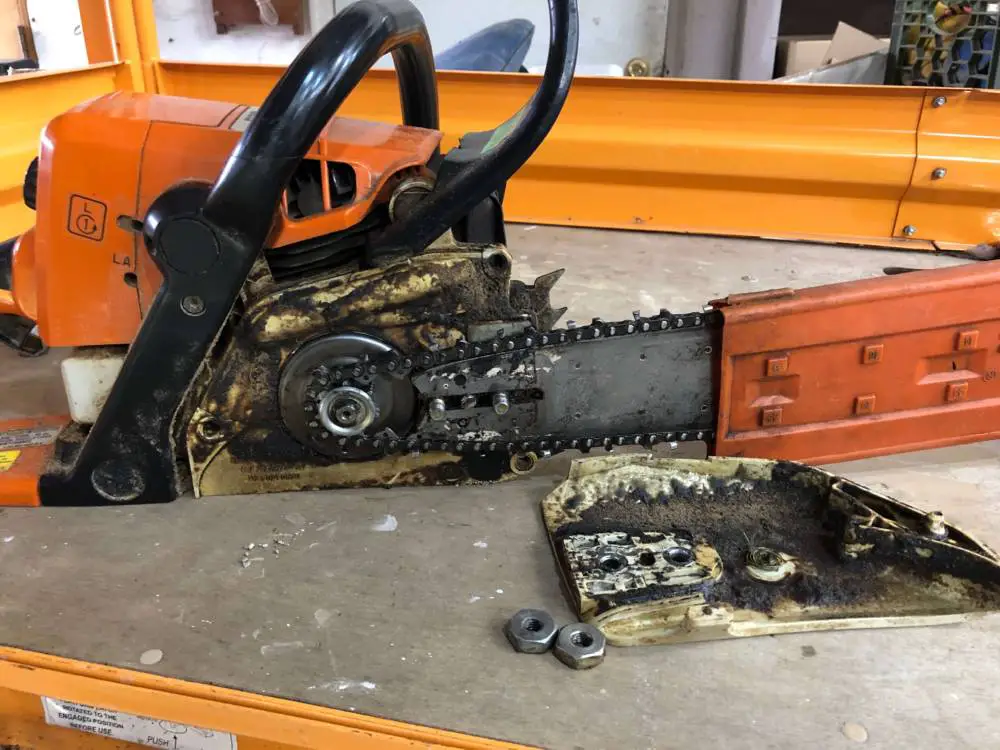
As you can tell, this chainsaw has lots of gunk inside (gunk is a technical term). When you clean your oiler, I recommend cleaning this inside portion of your saw and cover as well. Especially if it has this much sawdust and grime caked on it.
I just used some old packing paper to wipe it off and a screwdriver to get into all the nooks and crannies. If your gunk isn’t caked on, an air compressor could be a good way to clean it out as well.
If you need a more in-depth guide of how to remove a bar and chain, check out this post.
2. Clean the Oil Outlet Port
The oil outlet port is where the oil from your oil tank leaks out into the oil hole on your chainsaw bar. This little port can get gunked up with sawdust and debris.
The oil outlet port is located just behind the bar on your chainsaw. Here’s a picture of the one on the saw I’m cleaning out.
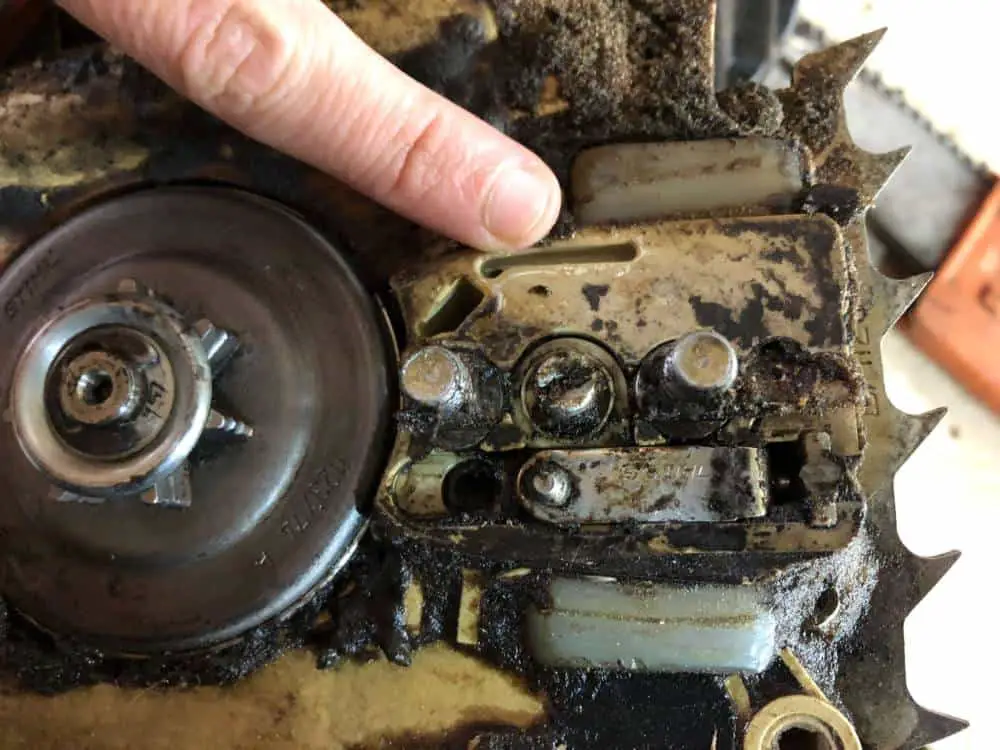
Suprisingly, my oil outlet port is clean, it’s the cleanest part of the entire chainsaw.
3. Clean the Oil Hole and Bar Groove
The next thing you need to clean out is the oil hole itself and the bar groove.
The oil hole on your chainsaw bar is a tiny little opening like the one shown below.

You can clean this out pretty easily using a thin file, a wire, or pretty much anything that will fit into it.
Scrape as much gunk off of it as you can.
Here’s a picture of the bar off the chainsaw I’m cleaning. As you can tell, the oil hole and the other holes on the bar are pretty covered with a sawdust and oil mix.
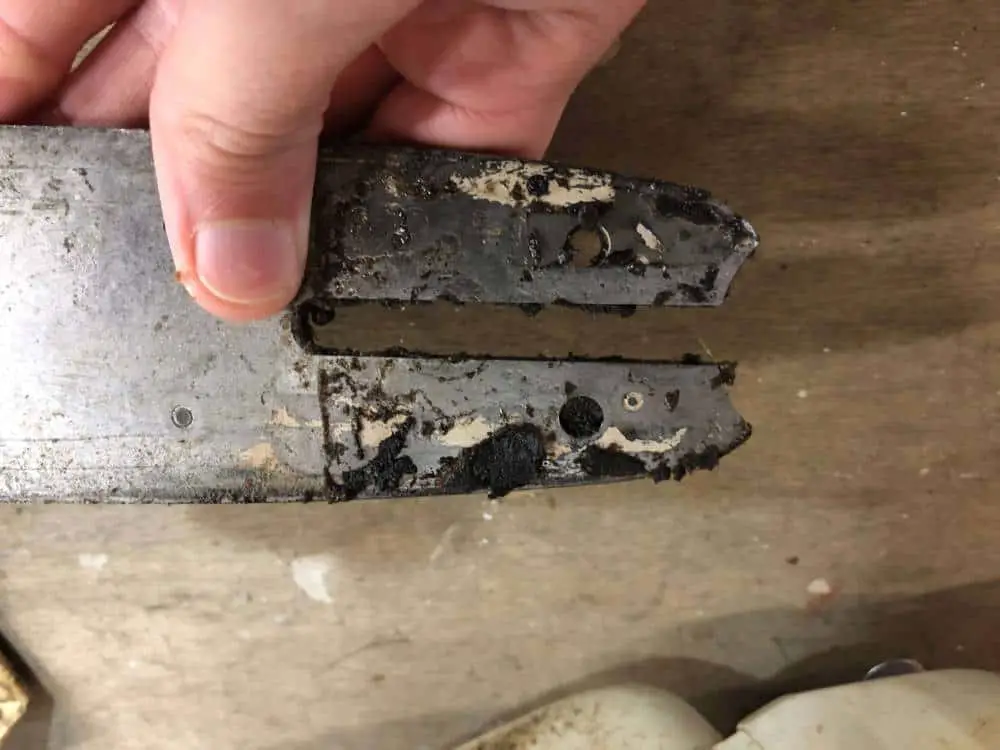
Remember, chainsaw bars are reversible which means there’s an oil hole on both sides. Make sure you clean them both.
The next thing you need to clean is your bar groove.
The bar groove can also get sawdust clogged in it which will keep oil from reaching every part of the chain even if your oiler is working perfectly.
You can clean this out by either using your gauge tool, or pretty much any tool that fits easily into your bar groove.
Here’s a picture of the bar I cleaned, it’s all shiny and fresh looking.
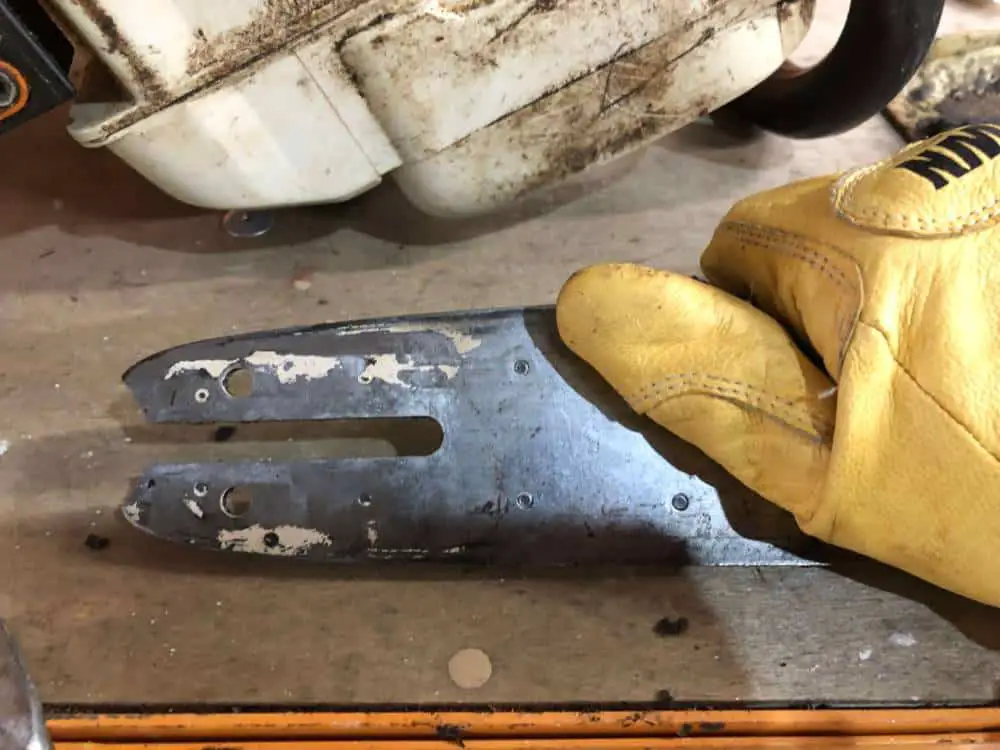
4. Reassemble the Saw
Once all the parts of your saw are cleaned, you just need to put it back together again.
Put your chain back on the bar and slide it back into place. Make sure your chain is facing the right direction.
Here’s my dirty chainsaw all cleaned up. It’s not perfect by any means but it certainly looks better than it did. I also put all the gunk I cleaned out of it in a pile next to the saw so you could see how much was in there.

5. Test the Oiler
Once you’ve put everything back together again (bar, chain, cover, etc.). The last thing you need to do is to test your chainsaw to make sure your oiler is now working correctly.
Fire up your saw and let it warm up. Then either get a log that needs to be cut, a piece of carboard, or something similar.
Hold your saw a few inches away from your chosen object and run your chain.
The thought here is that if your oiler works properly, it will spray oil off the tip of the saw. So, you should able to see a spray of oil going across the surface of whatever you chose to use.
If cleaning the oiler doesn’t work, then I’m afraid you’re dealing with a more serious issue. But before we jump to conclusions, use the below steps to test your oil pump.
How to Test Your Oil Pump
If you’re oiler still isn’t pumping oil like it should, then there’s probably something wrong with the oil pump. Let’s test this theory.
First, you need to remove your bar and chain from your saw (if you haven’t done so already). If you haven’t done this yet, and want detailed instructions, then check out this article.
Once your bar and chain are off, clean the oil outlet port. It’ll look something like this on your chainsaw:
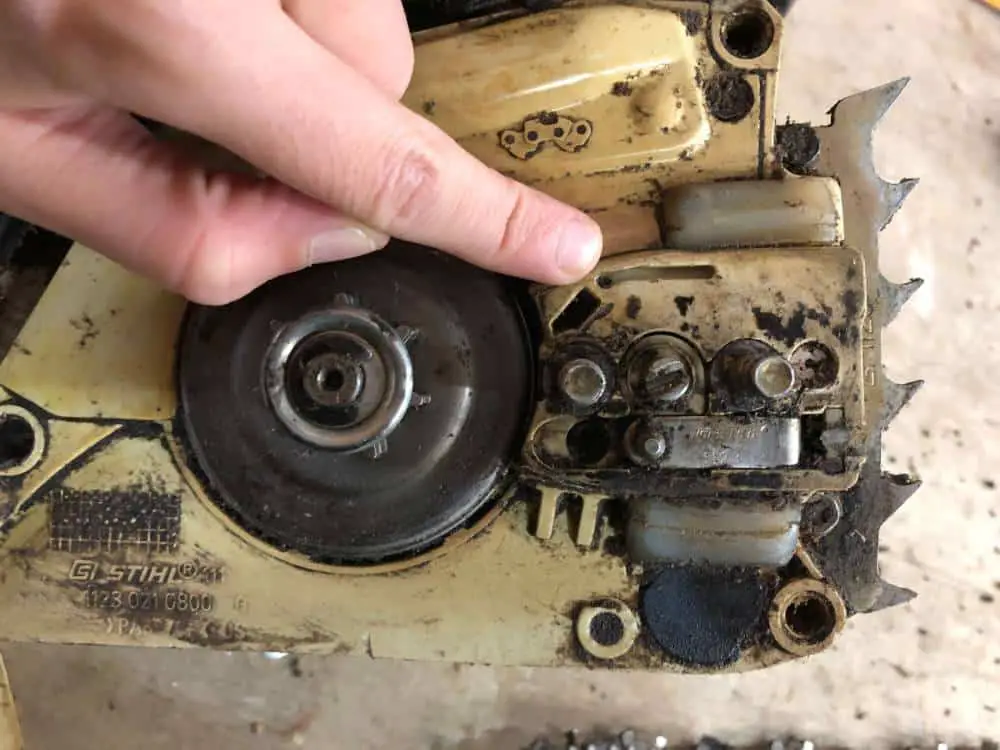
Once you’ve got that clean, fire up your saw. Yep, that’s right, you’re going to run your chainsaw with no chain on it.
Give your chainsaw a few minutes to idle and warm-up. Then rev your engine like you would when cutting something.
Oil should leak out of the oil outlet port.
If you see no oil AND you know your oil tank is full AND you’ve already thoroughly cleaned the oiler, then you have a problem with your oil pump or oil line.
Unfortunately, this is something a professional will have to help you with. Take your saw to your local repair shop and have them take a look.
Wrap-Up
There you have it, that’s all you need to know to figure out why your oiler isn’t working.
It was simpler than you thought, right?
Hopefully you learned something you didn’t know about chainsaws, and hopefully that knowledge will save you some money down the road.
As always, be safe out there and go do something awesome!
